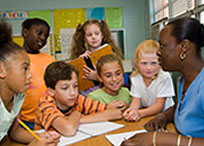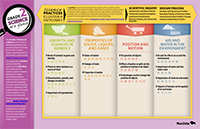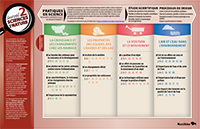
GRADE 2: SCIENCE
What your child is learning
In Grade 2, children learn about science by observing growth and changes of various animals and by comparing them to their own growth patterns. Children also learn about conditions needed for healthy growth, particularly nutritional needs. They explore the properties of solids, liquids and gases. They learn about the characteristics of air and water in their environment by examining the water cycle and investigating how air moves. Grade 2 children also explore position and motion to develop a sense of space and how pushes and pulls affect the motion of objects.
To find out more about what your child is learning, we encourage you to talk to the teacher. You may also find helpful information on the Curriculum Essentials posters, which are interactive PDFs designed for teachers that provide an overview of the knowledge, processes, and skills for this subject area.
The first page gives an overview of what your child will be learning, grouped into big ideas so that the curriculum is easier to understand. The number codes correspond to the curriculum learning outcomes. The arrow at the top of the page highlights the skills and attitudes, which are described in more detail on the third page. These should be integrated throughout the teaching and learning of science. The second page offers a more detailed description about the expectations related to the big ideas and the categories found on the provincial report cards regarding assessment.
You may also wish to refer to the Grades K-4 Science - Manitoba Curriculum Framework of Outcomes.
How your child is assessed
The teacher will assess your child’s progress in the areas described in the WHAT MY CHILD IS LEARNING tab. The teacher will also assess how your child uses scientific inquiry, solves problems and makes decisions in science. The reports you receive from the school help you to support your child’s learning. You can use them to talk with your child and your child’s teacher about results, strengths, challenges and what your child will be doing next.
Resources
Children are naturally curious and are eager to explore and discover the world that surrounds them. Cultivate this curiosity. Consider games and toys that nurture the design process and problem solving.
Here’s a few website you can start with to get some ideas.
Try Science – science activities for children and their families that can be done at home.
Let’s talk science offers a comprehensive database of science activities for the families.



 522 KB)
522 KB)
